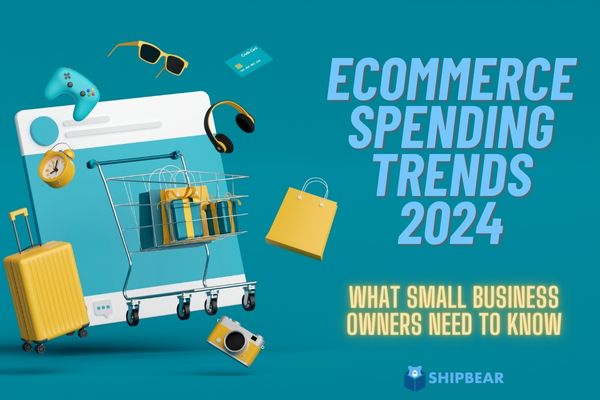The ecommerce landscape is rapidly evolving, with consumer behaviors and market dynamics shifting at an unprecedented pace.
For ecommerce entrepreneurs and small business owners, staying ahead of these trends is critical for maintaining competitiveness and driving growth.
This post explores the top ecommerce spending trends for 2024, offering insights and strategies to help you navigate these changes effectively.
Overview of Key Ecommerce Spending Trends for 2024
1. Increased Mobile Shopping
Mobile commerce, or m-commerce, continues to dominate the ecommerce space. With the proliferation of smartphones and improved mobile shopping experiences, consumers are increasingly making purchases via their mobile devices. According to a report from Forbes, mobile commerce sales will account for over half of total ecommerce sales by 2024.
2. Personalization and AI-Powered Shopping Experiences
Consumers expect personalized shopping experiences, and businesses leveraging AI technologies are set to meet this demand. AI enables hyper-targeted product recommendations, customized marketing messages, and seamless customer service interactions. As a result, personalized shopping experiences can significantly boost conversion rates and customer loyalty.
3. Sustainability and Ethical Shopping
Sustainability is no longer just a buzzword; it’s a decisive factor for many consumers. Shoppers are increasingly favoring brands that prioritize ethical practices and sustainability. Businesses that align their operations with these values are likely to attract a more loyal customer base and enjoy long-term success.
4. Subscription-Based Models
Subscription boxes and services are seeing a surge in popularity. Offering products on a subscription basis not only ensures recurring revenue but also fosters strong customer relationships. This trend is particularly prevalent in niches such as beauty, health, and wellness.
5. Social Commerce on the Rise
Social media platforms are becoming powerful sales channels. With features like shoppable posts and in-app checkout, platforms like Instagram, Facebook, and TikTok are facilitating direct purchases from social media. This trend is expected to continue its upward trajectory, making social commerce an essential strategy for ecommerce businesses.
Analysis of How These Trends Impact Ecommerce Entrepreneurs and Small Business Owners
Understanding these trends is the first step; the next is analyzing how they impact your business. Here’s a breakdown of what each trend means for ecommerce entrepreneurs and small business owners:
- Mobile Shopping: Ensure your website is mobile-optimized. Consider developing a dedicated mobile app to enhance the shopping experience.
- Personalization and AI: Invest in AI-driven tools and platforms to personalize customer interactions and improve decision-making processes.
- Sustainability: Evaluate your supply chain and product offerings. Consider eco-friendly packaging and sourcing ethically-produced goods.
- Subscription Models: Explore opportunities to offer your products as a subscription service. This model can stabilize revenue and increase customer retention.
- Social Commerce: Develop a robust social media strategy. Utilize shoppable posts and engage with your audience through live streams and stories.
Insights into Adapting Strategies to Leverage on the Trends

To leverage these trends effectively, small business owners need to adapt their strategies accordingly. Here are actionable insights to help you get started:
Optimize for Mobile
- Responsive Design: Ensure your website uses a responsive design to provide a seamless mobile experience.
- Speed: Optimize site speed for mobile users. Slow load times can lead to high bounce rates.
- User Experience (UX): Simplify navigation and checkout processes on mobile devices to reduce friction and improve conversions.
Harness the Power of AI
- Customer Segmentation: Use AI to segment your audience based on behavior, preferences, and purchase history.
- Chatbots: Implement AI-powered chatbots to provide 24/7 customer support and resolve queries instantly.
- Product Recommendations: Deploy recommendation engines to suggest products tailored to individual customers.
Embrace Sustainability
- Eco-Friendly Products: Source and offer products that are sustainable and ethically produced.
- Transparency: Be transparent about your sustainability practices. Educate your customers about the steps you’re taking to be environmentally responsible.
- Packaging: Use recyclable and biodegradable packaging materials.
Develop Subscription Services
- Market Research: Identify products that lend themselves well to a subscription model.
- Customer Feedback: Gather feedback to refine your subscription offerings and ensure they meet customer needs.
- Marketing: Promote your subscription services through targeted marketing campaigns.
Capitalize on Social Commerce
- Engage: Actively engage with your audience on social media platforms. Build a community around your brand.
- Content: Create visually appealing, shoppable content. Use high-quality images and videos to showcase your products.
- Influencers: Collaborate with influencers to reach a broader audience and build credibility.
Case Studies and Success Stories of Brands Navigating the Trends
Case Study 1: Glossier
Glossier, a beauty brand, has successfully leveraged social commerce to drive sales. By engaging with their audience on Instagram and using shoppable posts, they’ve created a loyal community of customers who advocate for their products. Their approach to personalization and social engagement has set them apart in the competitive beauty industry.
Case Study 2: Dollar Shave Club
Dollar Shave Club disrupted the grooming industry with its subscription-based model. By offering high-quality razors on a subscription basis, they’ve built a stable revenue stream and a strong customer base. Their success highlights the potential of subscription models in creating recurring revenue.
Case Study 3: Patagonia
Patagonia is a shining example of a brand that prioritizes sustainability. Their commitment to ethical practices and environmental responsibility has resonated with consumers, leading to increased brand loyalty and market share. Patagonia’s transparent approach to sustainability sets a benchmark for other businesses.
Takeaways
The ecommerce landscape in 2024 is set to be dynamic and filled with opportunities. By staying informed about the latest spending trends and adapting your strategies accordingly, you can position your business for success. Remember, the key is to be proactive and responsive to changes in consumer behavior and market dynamics.
As you embark on this journey, consider partnering with Shipbear, your all-in-one dropshipping agent. From sourcing and warehousing to fulfillment and logistics, Shipbear can help streamline your operations, allowing you to focus on scaling your business. Ready to take the next step? Message us at Shipbear today and discover how we can support your ecommerce success.
Transform your ecommerce strategy today and stay ahead of the curve. Let’s navigate the future of ecommerce together!



